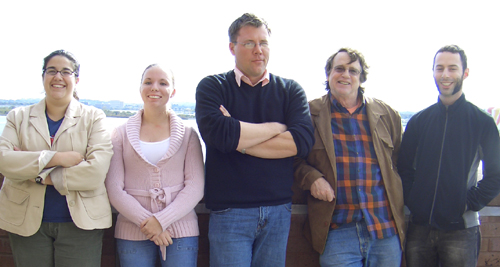
|
|
Editor's Introduction
ComTechReview and the CTC VISTA Project: Turning Inward and Looking Out Again
 CTC VISTA Project and CTR staff (2005-2006): Danielle Martin, Shannon McCue, Paul Hansen, Peter Miller, and Saul Baizman The current issue was conceived in the late spring, to be a much smaller special edition, focused on the CTC VISTA Project. It would be something in the nature of a yearbook, with a modest distribution, primarily for the Project's own members and alumni and perhaps of some use as an extended report/presentation/documentation. We're planning to focus on the Project's priority areas in future 2005-06 issues and otherwise giving responsibility over to Review Editorial Advisory Board to help with some serious brainstorming about the future directions of the publication. Happily, we have extended well beyond those initial modest goals and objectives. Dan Schackman has done an excellent job in focusing on some case studies and the different formats we have used in presenting a perspective on the Project since its inception—selecting and editing Tech for All Supervisor Doug Caldwell's report on Pete Rodriguez, Jason Crow's narrative on being an VISTA from the VISTA newsletter, Amanda Lasik's weblog entry on the meaning of her work at La Casa Hogar in rural Washington state. He solicited David Rosen's moving tribute and memorial for Larry Syms. He recruited Abby Balazs to report on her MoLLIE/Mobile Learning Lab work in Grand Rapids, Judy Hallman to provide an overview of the work of RTPnet's many VISTAs, Diana Hauer to explore what happened to Teaming for Technology after she left her VISTA work, and Carlos Pedraza to provide a Resource Center perspective. Dan’s also contributed a book review on the Corporation for National and Community Service. And we've got Saul Baizman, in his inimitable style, providing exemplary insights on how a wide range of nonprofits can benefit from his work in developing the CTC VISTA Project's information and communication systems. And, to complement our focus on AmeriCorps, Dan sought out complementary International perspectives focusing on the Peace Corps. That, in itself, would have gone well beyond what we originally conceived. But, in large part thanks to the efforts of new VISTA Assistant Editor Danielle Martin, we've also been able to kick start our planned coverage and resource development in the Project priority areas—Community Networking, Community Organizing and Development, Technology Assistance to Nonprofits, and Digital Media for Youth. We've done that with her summary reports of what went on at the August Preservice Orientation, supplemented by reports from others who attended, new VISTAs and supervisors alike, including Michael Maranda on community networking and AFCN, Karen Michaelson on TINCAN, Gene Crick on Telecommunity.US and new developments at the FCC, and Tara Kumar on CTCNet's Youth Visions for Stronger Neighborhoods. There are two other matters of note. First, in response to the devastation following in the wake of Hurricanes Katrina and Rita, both community technology and programs supported by the Corporation for National and Community Service, have played major roles. There's some key coverage about their timely response work here, some from brand new VISTAs Matthew Walker at CTCNet headquarters in DC and Nikki Payne with Technology for All in Houston, who were thrown directly into the midst of CTC response activities and, along with additional stories and resource notes, that make this issue timely and pertinent. ComTechReview as Customizable Interactive ICT/Community Media and Technology Curricular Text
For the last couple of issues on the inside back cover of the hard copy, we've been running a summary of contents from back issues along with a note "Discounted bulk copies available for classroom use, plus curriculum integration support." This issue is yet another example of how CTR content can be customized to meet special needs for those of you involved in education and helping people learn more about the field of community media and technology, by rearranging our sections and complementing them with resource sidebars and CTR archive links to material we have published since 2001. So in turning inward, we trust we are, in fact, reaching back out into the world with some particular useful perspectives, resources, and curriculum on community networking, community organizing and development, technology assistance to nonprofits, and digital media for youth. As always, we welcome your contributions and suggestions. —pm Hyperlinks references in this article: Comments
|